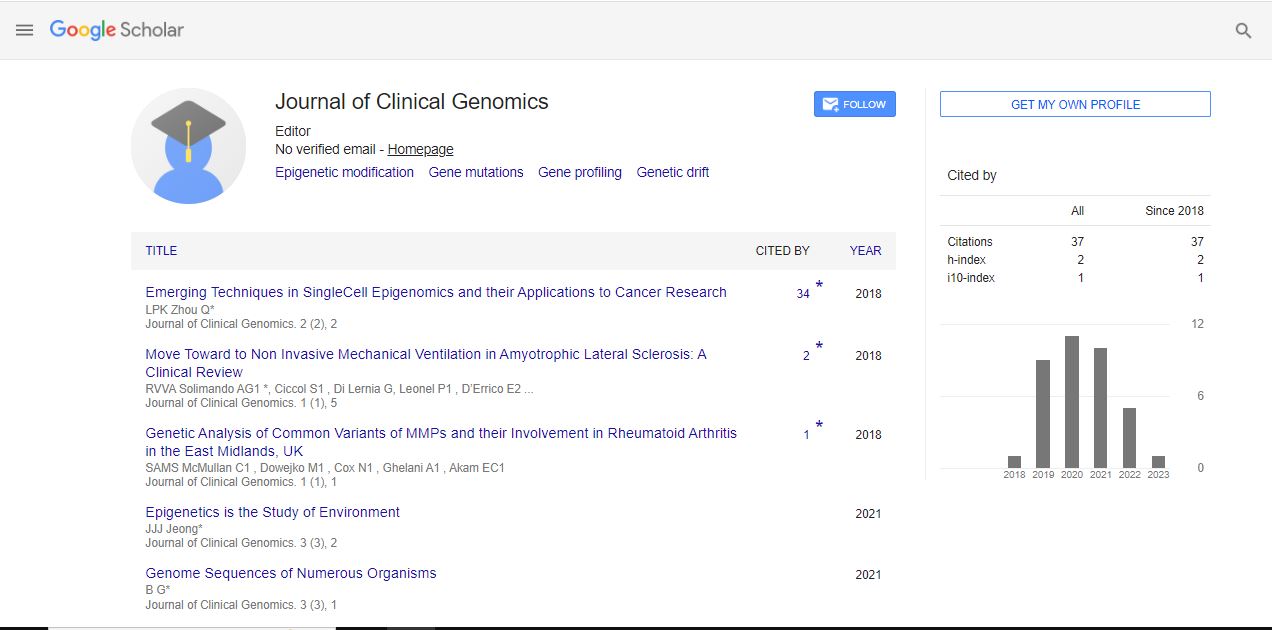Short Communication, J Chromatography Res Vol: 6 Issue: 2
Advancements of Chromatography: Principles, Classification, Applications
Wang Catherine*
1Department of Bio-Chemistry, University of Illinois at Chicago, Chicago, USA
*Corresponding Author: Wang Catherine,
Department of Bio-Chemistry,
University of Illinois at Chicago, Chicago, USA
E-mail: catherine.w@gmail.com
Received date: 02 June, 2023, Manuscript No. JCGR-23-107517;
Editor assigned date: 05 June, 2023, PreQC No. JCGR-23-107517 (PQ);
Reviewed date: 19 June, 2023, QC No. JCGR-23-107517;
Revised date: 26 June, 2023, Manuscript No. JCGR-23-107517 (R);
Published date: 06 July, 2023, DOI: 10.4172/JCGR.1000056.
Citation: Catherine W (2023) Advancements of Chromatography: Principles, Classification, Applications. J Chromatography Res 6:2.
Description
Chromatography is a powerful and widely used analytical technique in the field of chemistry. It serves as important equipment for separating and analyzing complicated combination of substances, enabling scientists to identify and quantify individual components within a sample. From its early origins in the 19th century to the highly sophisticated methods currently employed, chromatography has become an indispensable equipment in various industries, including pharmaceuticals, environmental monitoring, forensics, and biochemistry.
Principles of chromatography
Chromatography is based on the principle of differential migration of components in a combination as a result of their interactions with two stages: The stationary phase and the phase of mobility. The stationary phase is a solid or liquid material that remains fixed in place during the separation process, while the mobile phase is a fluid that moves over or through the stationary phase. As the combination is introduced into the system, its components will exhibit varying affinities for the stationary and mobile phases, causing them to separate based on their individual properties [1-3].
Types of Chromatography
Thin-layer chromatography: Thin-Layer Chromatography (TLC) is one of the simplest forms of chromatography, widely used in laboratories for rapid qualitative analysis. In an aluminum or metal plate, a sample appears towards the center of a thin layer of stationary material (typically silica gel or alumina). The plate is then placed in a solvent-filled chamber, allowing the mobile phase (solvent) to move up the plate through capillary action. As the solvent travels, it carries the sample components at different rates, resulting in distinct spots on the plate that can be visualized and analyzed [4,5].
Gas chromatography: Gas Chromatography (GC) is utilized for separating volatile compounds based on their vaporization and interaction with a stationary phase inside a column. The sample is injected as a gas or vapor into the column, and an inert gas (the mobile phase) carries the sample through the column. The components' interactions with the stationary phase cause them to separate, and a detector at the end of the column quantifies the separated compounds, producing a chromatogram [6].
Liquid chromatography: Liquid Chromatography (LC) encompasses several variations, but all involve the separation of components based on their interactions with a liquid mobile phase and a stationary phase. High-Performance Liquid Chromatography (HPLC) is particularly popular due to its versatility and high resolution. HPLC employs high-pressure pumps to push the mobile phase through a column packed with a stationary phase, allowing for precise control and efficient separation of complex mixtures.
Applications of chromatography
Pharmaceuticals: Chromatography is essential equipment in pharmaceutical research and development. It helps in the analysis of drug compounds, ensuring purity, identifying impurities, and determining the active ingredient's concentration. In general, HPLC is widely used to test pharmaceutical products for quality control, ensuring the safety and efficacy of medications before they reach the market [7].
Environmental monitoring: It plays a significant role in environmental analysis by detecting and quantifying pollutants and contaminants in air, water, soil, and food samples. Gas Chromatography-Mass Spectrometry (GC-MS) is frequently used in environmental monitoring to identify Volatile Organic Compounds (VOCs) and other hazardous substances.
Forensic science: In forensic laboratories, chromatography is employed to analyze complex mixtures of substances found at crime scenes or in biological samples. Gas chromatography and liquid chromatography are used to identify drugs, toxic substances, and trace evidence, contributing to the investigation and resolution of criminal cases [8].
Biochemistry: It is the foundation technique in biochemistry, enabling the separation and purification of biomolecules such as proteins, nucleic acids, and carbohydrates. Affinity chromatography, size exclusion chromatography, and ion exchange chromatography are some of the specialized techniques used in biochemistry research and biotechnology processes.
Advancements in chromatography
During the years, chromatography has undergone significant advancements to improve sensitivity, resolution, and efficiency. The significant advancements are:
High-efficiency columns: Columns with smaller particle sizes and higher packing efficiencies have resulting in larger separations and higher resolution of components [9].
Advanced detectors: Modern detectors, such as mass spectrometers and diode array detectors, provide more comprehensive and specific information about the separated compounds, allowing for accurate identification and quantification.
Automation and robotics: Automation has streamlined the chromatographic process, reducing human error and increasing the throughput of samples, enhancing it more ability for high-throughput analysis in various industries [10].
References
- Lough WJ, Wainer IW (1995) High performance liquid chromatography: Fundamental principles and practice. CRC press 30.
- Cielecka-Piontek J, Zalewski P, Jelińska (2013) The greening face of liquid chromatography. Chromatographia 76:1429-1437.
[Crossref] [Google Scholar] [Pub Med]
- Bressolle F, Bromet-Petit M (1996) Validation of liquid chromatographic and gas chromatographic methods Applications to pharmacokinetics. BioMed Sci Appl 686:3-10.
[Crossref] [Google Scholar] [Pub Med]
- Fanali S, Haddad PR, Poole C (2017) Liquid chromatography: Applications. Elsevier 25.
- Akash MS, Rehman K (2020) High performance liquid chromatography. Pharm Anal 175-84.
- Niessen WM (2006) Liquid chromatography-mass spectrometry. CRC press.
- Pereira A (2010) Green chromatography introduction and liquid chromatography. LC GC Eur 23:242-259.
- Bird IM (1989) High performance liquid chromatography: Principles and clinical applications. Brit Med J 299:783.
[Crossref] [Google Scholar] [Pub Med]
- Kostanyan AE, Voshkin AA (2009) Support-free pulsed liquidliquid chromatography. J Chromatogr. 1216.
[Crossref] [Google Scholar] [Pub Med]
- Den Uijl MJ, Schoenmakers P (2021) Recent applications of retention modelling in liquid chromatography. J Sep Sci 44:88-114.
[Crossref] [Google Scholar] [Pub Med]
 Spanish
Spanish  Chinese
Chinese  Russian
Russian  German
German  French
French  Japanese
Japanese  Portuguese
Portuguese  Hindi
Hindi 